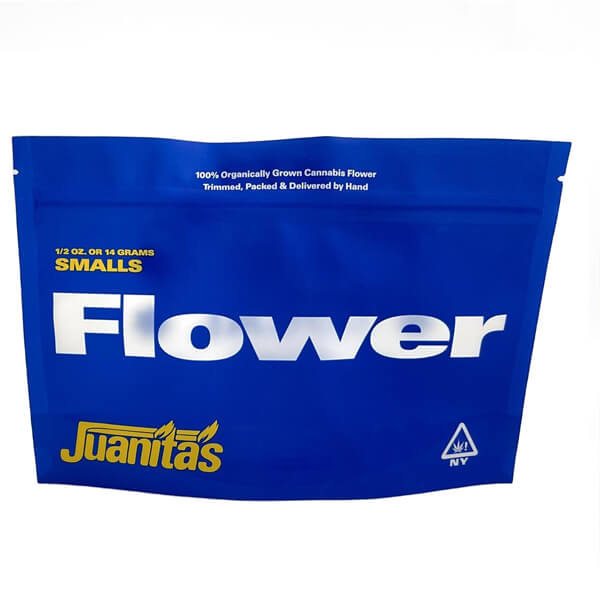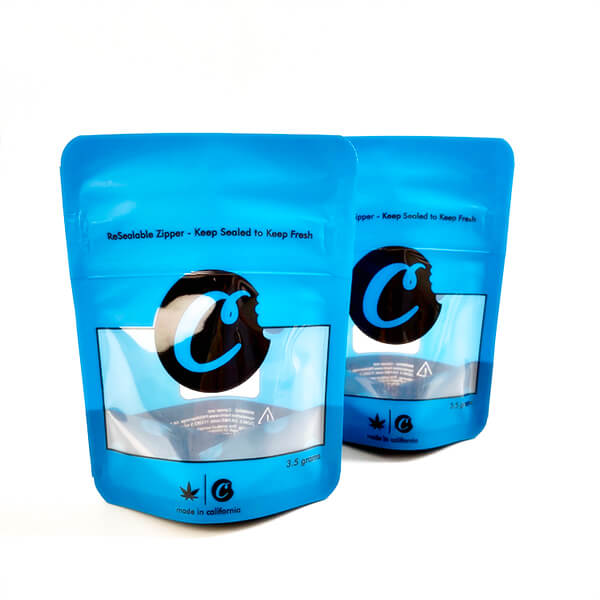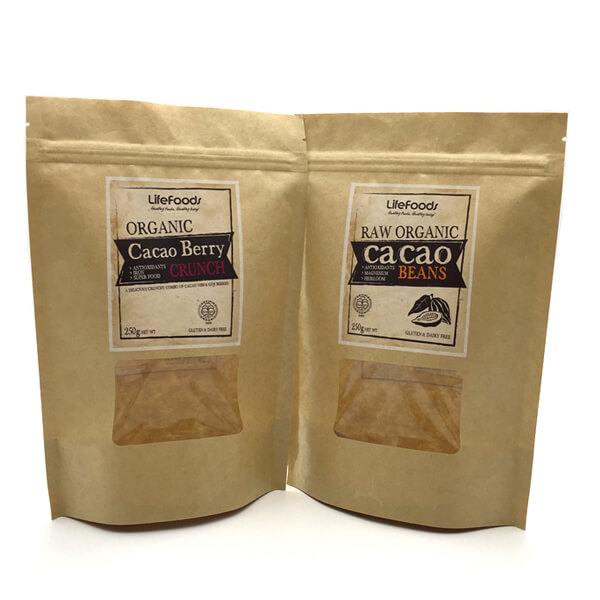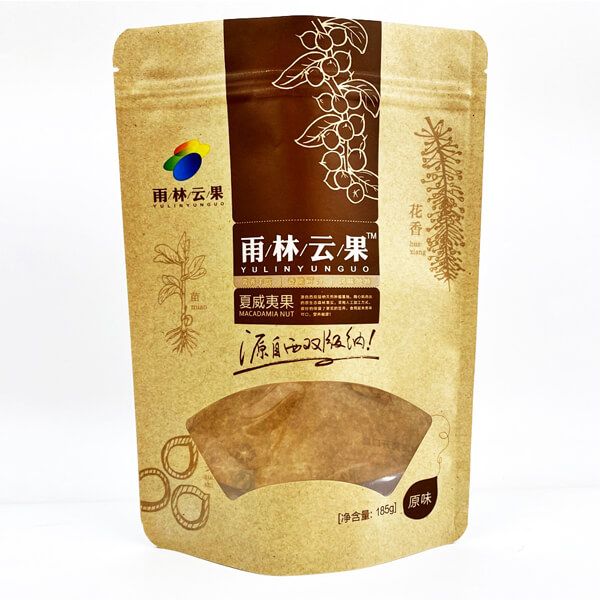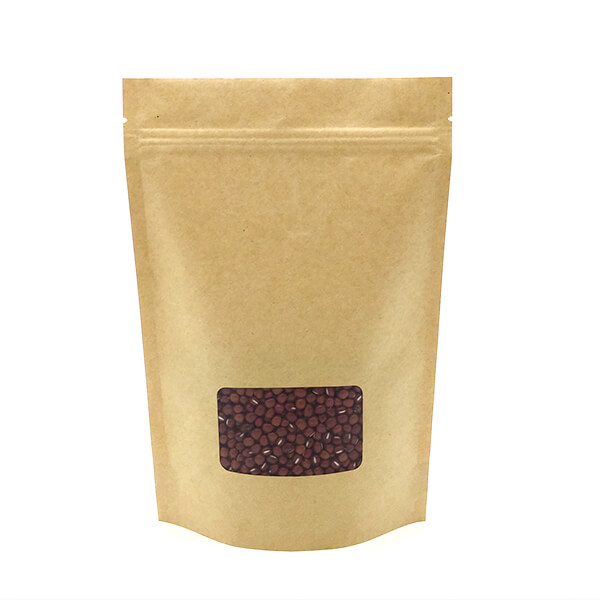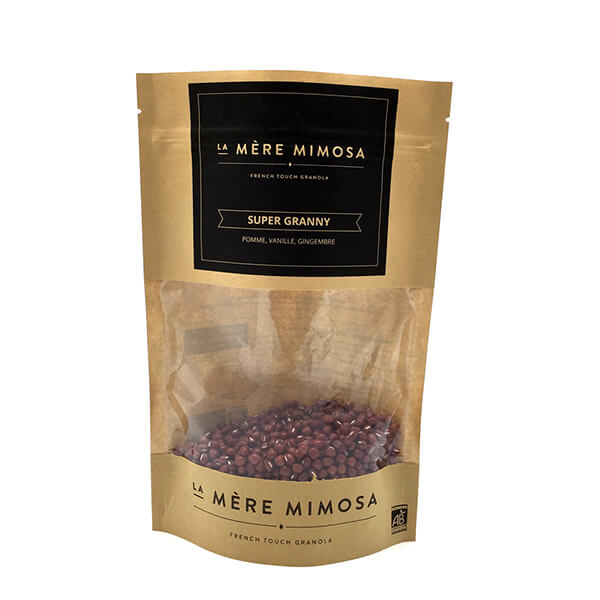Home » Bags & Pouches » Window Pouches » Window Pouches For Cannabis Flower Packaging
Window Pouches For Cannabis Flower Packaging
Window pouches for cannabis flower packaging stand up on their own and feature a window to allow your customer to peek inside the bag and view the product. The bag has medium storage properties and can adequately protect the contents from external influences.
Please note that we have a MOQ for our pouch. For pouches in stock, the MOQ is 500 pcs. For customized pouches, please see the MOQ as followed:
1, Digital Printing — 500 pcs
2, Gravure Printing — 5,000pcs
Rinpac assists you throughout your project: bag shape, material, thickness, capacity and printing options. Please contact us or mark your requirements on the inquiry quotation.
Order single or thousands of items at a time. Our warehouse and flexible shipping options are available for last-minute, deadline critical orders.
- Free Sample
*Customization is always available, please mark down your need in cart or just contact us.
Specification
| MOQ | 500 PCS |
| Size | Per customer’s request |
| Material | BOPP/PET/NY+AL/PETAL/Kraft Paper/+LLDPE/CPP |
| Thickness | Per customer’s request |
| Custom Order | Accept |
| OEM | Yes |
| Sealing & Handle | Heat seal,zipper,hang hole |
Video
Request A Quote
Need something helped in a short time? We’ve got a plan for you.
Introduction to Window Pouches
Window pouches are a versatile and innovative packaging solution that combines the convenience of flexible pouch packaging with the visibility of a transparent window. These pouches feature a transparent panel, typically made of clear plastic or film, that allows consumers to see the product inside without opening the package.
Window pouches are commonly used across various industries, including food and beverage, personal care, pharmaceuticals, and more. They offer several benefits, including enhanced product visibility, branding opportunities, and consumer convenience.
In this article, we will explore the features, benefits, applications, and considerations associated with window pouches, highlighting their importance in modern packaging solutions and their role in meeting consumer expectations for transparency and convenience.
Importance of Packaging in the Cannabis Industry
Packaging plays a crucial role in the cannabis industry for several reasons, ranging from regulatory compliance to consumer safety and brand differentiation. Here are some key factors highlighting the importance of packaging in the cannabis sector:
Regulatory Compliance
Legal Requirements: The cannabis industry is heavily regulated, with strict requirements for packaging and labeling to ensure compliance with local laws and regulations. Proper packaging is essential to meet legal obligations regarding child-resistant packaging, product information, dosage, and health warnings.
Track-and-Trace: Packaging serves as a vital component of track-and-trace systems implemented by regulatory authorities to monitor the movement of cannabis products from cultivation and processing to retail sale. Each package must be uniquely identified and labeled to facilitate traceability and regulatory oversight.
Product Protection and Safety
Preservation of Freshness: Proper packaging helps preserve the potency, flavor, and freshness of cannabis products, including flowers, edibles, concentrates, and topicals. Airtight and light-resistant packaging prevents degradation caused by exposure to oxygen, moisture, and UV light, ensuring product quality and efficacy.
Contamination Prevention: Secure packaging safeguards cannabis products from contamination by external factors such as microbes, pests, and environmental pollutants. Sealed and tamper-evident packaging minimizes the risk of adulteration and ensures consumer safety and confidence in product integrity.
Brand Differentiation and Consumer Experience
Brand Identity: Packaging serves as a powerful tool for brand differentiation and recognition in a competitive market. Unique and eye-catching packaging designs, logos, and branding elements help cannabis companies establish their identity and stand out on dispensary shelves, attracting consumers and building brand loyalty.
Consumer Education: Informative packaging provides consumers with essential product information, including potency, cannabinoid profiles, ingredients, dosage instructions, and potential effects. Clear and accurate labeling empowers consumers to make informed purchasing decisions and ensures responsible consumption.
Sustainability and Environmental Responsibility
Reduced Environmental Impact: Sustainable packaging practices, such as using recyclable, compostable, or biodegradable materials, contribute to environmental conservation and waste reduction in the cannabis industry. Eco-friendly packaging solutions minimize carbon footprint and support sustainability initiatives, aligning with consumer preferences for environmentally responsible products.
Regenerative Farming: Packaging choices can also reflect a commitment to regenerative farming practices and ethical sourcing of cannabis products. Eco-conscious packaging options promote environmental stewardship and social responsibility, appealing to environmentally conscious consumers and enhancing brand reputation.
In summary, packaging plays a multifaceted role in the cannabis industry, encompassing regulatory compliance, product protection, branding, consumer education, and sustainability. By prioritizing effective packaging strategies, cannabis companies can navigate regulatory challenges, enhance product quality and safety, differentiate their brands, and foster positive consumer experiences in a rapidly evolving market landscape.
Evolution of Cannabis Packaging
The evolution of cannabis packaging has undergone significant transformations, reflecting changes in regulatory requirements, consumer preferences, and industry advancements. Here’s a look at the transition from traditional packaging methods to modern solutions:
Traditional Packaging Methods
Bulk Containers: In the early days of the cannabis industry, products were often sold in bulk containers such as jars or bags without much consideration for branding or consumer convenience. These basic packaging methods lacked sophistication and often did not meet regulatory requirements for child-resistant packaging or product labeling.
Opaque Packaging: To comply with regulations and preserve product integrity, cannabis products were commonly packaged in opaque containers or pouches to protect them from light exposure, moisture, and air. While effective for product protection, opaque packaging limited consumer visibility and branding opportunities.
Shift Towards Modern Packaging Solutions
Child-Resistant Packaging: As cannabis legalization expanded and regulations became more stringent, there was a growing emphasis on child-resistant packaging to prevent accidental ingestion by children. Modern packaging solutions incorporate child-resistant features such as locking mechanisms, resealable closures, or blister packs to meet safety requirements.
Branding and Design: With the maturation of the cannabis market, there has been a shift towards branded packaging and innovative design to differentiate products and attract consumers. Cannabis companies invest in eye-catching graphics, logos, and packaging materials to establish brand identity and appeal to target demographics.
Functional and Sustainable Materials: Modern packaging solutions prioritize functionality and sustainability, utilizing materials such as recyclable plastics, biodegradable films, or compostable substrates to reduce environmental impact. Sustainable packaging options align with consumer preferences for eco-friendly products and support corporate responsibility initiatives.
Diverse Product Formats: The expansion of cannabis product offerings beyond traditional flower to include edibles, concentrates, topicals, and pre-rolls has driven innovation in packaging design and formats. Packaging solutions are tailored to accommodate different product forms, dosage requirements, and consumption methods, enhancing consumer convenience and product accessibility.
Compliance and Traceability: Robust regulatory frameworks mandate comprehensive labeling requirements and track-and-trace systems to ensure product safety and regulatory compliance. Modern packaging solutions integrate barcode labels, QR codes, and batch numbers to facilitate traceability and regulatory oversight throughout the supply chain.
In summary, the evolution of cannabis packaging reflects industry maturation, regulatory compliance, and consumer-driven demand for functional, aesthetically pleasing, and sustainable packaging solutions. By embracing modern packaging trends and innovations, cannabis companies can enhance brand visibility, product safety, and consumer satisfaction in a competitive market landscape.
What are Window Pouches?
Window pouches are a type of flexible packaging that combines the benefits of traditional pouch packaging with the added feature of a transparent window. This window, typically made of clear plastic or film, allows consumers to see the contents of the pouch without the need to open it. Window pouches are commonly used across various industries, including food and beverage, snacks, pet food, personal care products, and more.
Features of Window Pouches:
Transparent Window: The defining feature of window pouches is the transparent panel incorporated into the packaging. This window provides a clear view of the product inside, allowing consumers to inspect the contents, assess product quality, and make informed purchasing decisions.
Flexible Packaging: Window pouches are made of flexible materials such as plastic films or laminates, which offer advantages such as lightweight construction, space-saving storage, and ease of transportation. The flexible nature of these pouches also allows for efficient filling, sealing, and handling during production and distribution.
Product Protection: Despite their transparency, window pouches provide effective protection for the packaged products. The materials used in window pouch construction offer barrier properties that safeguard the contents from external factors such as moisture, oxygen, light, and contaminants, ensuring product freshness and integrity.
Branding Opportunities: Window pouches offer ample space for branding elements, including logos, product names, and promotional messages. The transparent window provides a unique canvas for showcasing the product and its features, enhancing brand visibility and attracting consumer attention on retail shelves.
Consumer Convenience: The transparent window allows consumers to preview the product inside the pouch before making a purchase, reducing the need to open multiple packages to find the desired item. This convenience enhances the shopping experience and encourages impulse purchases by providing a clear view of the product’s appearance and characteristics.
Versatility: Window pouches are available in various shapes, sizes, and configurations to accommodate different product types and packaging requirements. Whether used for snacks, pet treats, personal care products, or household items, window pouches offer versatility and adaptability to meet diverse consumer needs.
In summary, window pouches are a versatile and functional packaging solution that combines visibility, product protection, branding opportunities, and consumer convenience. With their transparent window and flexible construction, window pouches offer an attractive and practical packaging option for a wide range of products across industries.
Benefits of Window Pouches for Cannabis Flower Packaging
Window pouches offer numerous advantages for packaging cannabis flower, providing both practical and aesthetic benefits that cater to the needs of consumers and manufacturers alike. Here are some key benefits of using window pouches for cannabis flower packaging:
Transparency and Visibility
Clear View of Product: The transparent window on window pouches allows consumers to see the cannabis flower inside without opening the package. This transparency enables customers to inspect the quality, color, and trichome coverage of the flower, enhancing their confidence in the product’s freshness and potency.
Enhanced Consumer Experience: By providing a clear view of the cannabis flower, window pouches create a more engaging and interactive shopping experience for consumers. Customers can visually assess the product before purchase, leading to greater satisfaction and reduced likelihood of returns or exchanges.
Branding Opportunities
Customizable Design: Window pouches offer ample space for branding elements, including logos, graphics, and product information. Manufacturers can leverage this space to showcase their brand identity, differentiate their products, and communicate key selling points such as strain information, THC/CBD content, and cultivation practices.
Eye-Catching Presentation: The combination of transparent window and custom branding creates an eye-catching presentation on dispensary shelves. Window pouches stand out from traditional opaque packaging, attracting the attention of consumers and encouraging impulse purchases.
Protection from External Elements
Preservation of Freshness: Window pouches provide effective protection for cannabis flower, shielding it from exposure to light, moisture, oxygen, and contaminants. The barrier properties of the packaging materials help maintain the freshness, flavor, and potency of the flower, prolonging its shelf life and ensuring product quality.
Tamper-Evident Features: Many window pouches are equipped with tamper-evident seals or resealable closures, adding an extra layer of protection against tampering and unauthorized access. These features enhance product security and reassure consumers of the product’s safety and integrity.
Sustainability and Eco-Friendliness
Recyclable Materials: Window pouches can be made from recyclable materials such as paper, cardboard, or recyclable plastics, reducing environmental impact and supporting sustainability initiatives. Manufacturers can choose eco-friendly packaging options to minimize waste generation and promote a circular economy.
Biodegradable Options: Some window pouches are available in biodegradable or compostable variants, further reducing their environmental footprint. These eco-friendly packaging solutions decompose naturally after use, contributing to the reduction of plastic pollution and environmental conservation efforts.
In summary, window pouches offer a range of benefits for cannabis flower packaging, including transparency, branding opportunities, product protection, and sustainability. By leveraging the features and advantages of window pouches, cannabis companies can enhance the visibility, appeal, and marketability of their products in a competitive industry landscape.
Types of Window Pouches
Window pouches come in various types, each offering unique features and benefits tailored to specific packaging needs and product requirements. Here are some common types of window pouches categorized by materials and designs:
Material-Based Window Pouches
Plastic Window Pouches: These window pouches feature a transparent window made of plastic material such as polyethylene (PE), polypropylene (PP), or polyethylene terephthalate (PET). Plastic window pouches offer excellent clarity and durability, making them suitable for showcasing products with vibrant colors and intricate details.
Clear Film Window Pouches: Clear film window pouches are crafted from transparent films such as polyethylene terephthalate (PET), oriented polypropylene (OPP), or polyvinyl chloride (PVC). These pouches provide high clarity and flexibility, allowing for creative designs and customization options while maintaining product visibility.
Biodegradable Window Pouches: As eco-conscious packaging solutions gain popularity, biodegradable window pouches made from compostable materials such as bio-based plastics, paper, or plant-derived films offer a sustainable alternative. These pouches decompose naturally after use, reducing environmental impact and promoting eco-friendliness.
Design-Based Window Pouches
Stand-Up Window Pouches: Stand-up window pouches feature a gusseted bottom that allows them to stand upright on retail shelves, maximizing product visibility and shelf presence. These pouches are ideal for displaying a variety of products, including snacks, pet treats, and personal care items, in a space-efficient manner.
Flat Bottom Window Pouches: Flat bottom window pouches, also known as block bottom or quad-seal pouches, feature a rectangular base that provides stability and support for heavier or bulkier products. The flat bottom design allows the pouch to stand securely on shelves, enhancing product presentation and consumer convenience.
Zipper Closure Window Pouches: Window pouches with zipper closures offer resealable functionality, allowing consumers to open and close the pouch multiple times while keeping the contents fresh and secure. These pouches are popular for packaging snacks, dried fruits, and other perishable items that require extended shelf life.
Printed Window Pouches: Printed window pouches incorporate vibrant graphics, logos, and branding elements directly onto the packaging material, creating visually appealing designs that attract consumer attention. Custom printing options enable manufacturers to showcase product information, promotions, and marketing messages effectively.
In summary, window pouches are available in a variety of types, including plastic, clear film, biodegradable, stand-up, flat bottom, zipper closure, and printed designs. By selecting the appropriate type of window pouch based on materials and designs, manufacturers can optimize product visibility, protection, and marketability in diverse packaging applications.
Factors to Consider When Choosing Window Pouches
When selecting window pouches for packaging purposes, several factors must be taken into account to ensure optimal performance, compliance, and customer satisfaction. Here are key considerations to keep in mind:
Size and Capacity
Product Dimensions: Determine the appropriate size of the window pouches based on the dimensions of the packaged product, including length, width, and height. The pouch should accommodate the product comfortably without excessive empty space or overstuffing.
Capacity Requirements: Consider the volume or weight capacity needed for the packaged product. Choose window pouches with sufficient capacity to hold the desired quantity of goods while maintaining structural integrity and stability.
Barrier Properties
Material Selection: Evaluate the barrier properties of the pouch materials to ensure adequate protection against external factors such as moisture, oxygen, light, and contaminants. Opt for high-quality materials with barrier coatings or laminates that maintain product freshness and shelf life.
Transparency and Clarity: Assess the transparency and clarity of the window material to ensure optimal product visibility. The window should provide a clear view of the contents while preserving visual appeal and product presentation.
Regulations Compliance
Child-Resistant Packaging: Ensure that the window pouches comply with relevant regulations for child-resistant packaging in jurisdictions where such requirements apply. Select pouches with certified child-resistant features or incorporate additional child-resistant closures as needed.
Labeling and Information Requirements: Verify that the window pouches allow for proper labeling and information display in compliance with regulatory guidelines. Ensure that essential product information, including potency, ingredients, warnings, and dosage instructions, can be clearly communicated on the packaging.
Sustainability Considerations: Evaluate the environmental impact of the window pouches and their compliance with sustainability regulations or industry standards. Choose pouches made from recyclable, biodegradable, or compostable materials to minimize environmental footprint and support sustainable packaging initiatives.
Manufacturing and Supply Chain Considerations
Supplier Reliability: Partner with reputable suppliers or manufacturers with a track record of quality and reliability in producing window pouches. Ensure that the supplier can meet production deadlines, quality standards, and volume requirements consistently.
Supply Chain Efficiency: Consider logistical factors such as transportation, storage, and distribution when choosing window pouches. Select pouches that optimize space utilization, minimize packaging waste, and facilitate efficient handling and shipping throughout the supply chain.
By carefully considering factors such as size and capacity, barrier properties, regulations compliance, and manufacturing considerations, businesses can select window pouches that meet their specific packaging needs effectively. Choosing the right window pouches ensures product integrity, regulatory compliance, and consumer satisfaction in packaging applications across industries.
Trends and Innovations in Window Pouches
As the packaging industry continues to evolve, window pouches have undergone significant advancements and innovations to meet changing consumer preferences, regulatory requirements, and sustainability goals. Here are some of the latest trends and innovations shaping the development of window pouches:
Advanced Barrier Technologies
High-Performance Films: Manufacturers are developing advanced barrier films with enhanced properties to protect products from oxygen, moisture, light, and other external factors. These films improve shelf life, preserve product freshness, and maintain flavor and aroma integrity.
Active Packaging Solutions: Active packaging technologies such as oxygen scavengers, moisture absorbers, and antimicrobial agents are being integrated into window pouch designs to actively extend product shelf life and enhance quality throughout the packaging lifecycle.
Sustainable Materials and Design
Recyclable and Biodegradable Options: There is a growing demand for window pouches made from recyclable, biodegradable, or compostable materials to reduce environmental impact and support circular economy initiatives. Manufacturers are exploring innovative materials derived from renewable sources or incorporating post-consumer recycled content.
Minimalist Designs: Sustainable packaging trends favor minimalist designs that optimize material usage and reduce packaging waste. Window pouches with sleek, lightweight designs and minimalist graphics contribute to resource conservation and eco-friendly branding.
Smart Packaging Integration
Intelligent Packaging Features: Window pouches are incorporating smart packaging technologies such as NFC (Near Field Communication) tags, QR codes, and RFID (Radio-Frequency Identification) labels to provide consumers with access to product information, authentication, and interactive experiences via smartphones and other devices.
Track-and-Trace Solutions: Manufacturers are implementing track-and-trace systems in window pouch packaging to enhance supply chain visibility, product authentication, and regulatory compliance. These systems enable real-time monitoring of product movement, inventory management, and quality control throughout the distribution process.
Customization and Personalization
Digital Printing Technologies: Advanced digital printing techniques allow for highly customizable and personalized window pouch designs with vibrant colors, intricate patterns, and variable data printing capabilities. Brands can create unique packaging designs tailored to specific product lines, promotions, or customer segments.
Interactive Packaging Elements: Window pouches are incorporating interactive elements such as augmented reality (AR) experiences, gamification features, and scannable codes to engage consumers and enhance brand storytelling. These interactive packaging elements create memorable brand experiences and foster consumer loyalty.
Enhanced Convenience and Functionality
Convenient Opening and Closure Mechanisms: Window pouches are incorporating user-friendly opening and closure mechanisms such as zipper seals, tear notches, and resealable features to improve convenience and product freshness for consumers.
Multi-Compartment Pouches: Innovative designs include window pouches with multiple compartments or chambers, allowing for convenient segregation of different product components or flavors within the same package.
Cost Considerations in Window Pouch Packaging
When evaluating window pouch packaging solutions, it’s essential to consider various cost factors to ensure cost-effectiveness while meeting product requirements and business objectives. Here’s a comparative analysis of cost considerations for window pouches compared to other packaging solutions:
Material Costs
Initial Investment: The cost of materials for window pouches may vary depending on the type of material used, such as plastic films, laminates, or biodegradable alternatives. Initial investment in materials for window pouches may be comparable to or slightly higher than other packaging solutions, depending on the specific material requirements and customization options.
Long-Term Savings: While the upfront cost of materials for window pouches may be higher, the long-term savings can be significant due to factors such as reduced material usage, lightweight construction, and space-saving design. Window pouches often offer cost savings in transportation, storage, and disposal compared to bulkier or less efficient packaging alternatives.
Production and Manufacturing Costs
Production Efficiency: Window pouches can be produced efficiently using automated manufacturing processes such as roll-to-roll printing, pouch forming, and sealing. The production efficiency of window pouches contributes to lower labor costs, reduced production times, and increased throughput compared to manual or labor-intensive packaging methods.
Customization Costs: The cost of customizing window pouches with branding elements, graphics, and special features may vary depending on the complexity of the design, printing techniques used, and order quantities. While customization adds value and enhances brand visibility, it may incur additional costs compared to standard or unprinted packaging options.
Transportation and Logistics Costs
Shipping Efficiency: Window pouches offer advantages in terms of lightweight construction, compact packaging, and stackability, resulting in reduced shipping costs per unit compared to bulkier or less space-efficient packaging solutions. The efficient use of space in transportation vehicles and warehouses contributes to lower freight costs and improved logistics efficiency.
Storage and Inventory Management: The compact design and stackability of window pouches facilitate efficient storage and inventory management, reducing warehousing costs associated with space utilization, inventory turnover, and product accessibility compared to bulky or irregularly shaped packaging alternatives.
Environmental and Sustainability Costs
Life Cycle Analysis: While window pouches may incur higher initial material costs compared to conventional packaging solutions, their environmental benefits and sustainability credentials can lead to long-term cost savings and positive brand reputation. Reduced environmental impact, lower waste disposal costs, and alignment with corporate sustainability goals contribute to overall cost-effectiveness in the long run.
Compliance and Certification: Window pouches made from recyclable or biodegradable materials may require certification or compliance with environmental regulations and industry standards, which may entail additional costs for testing, auditing, and certification processes. However, these investments in sustainability can yield cost savings through reduced environmental liabilities and enhanced market competitiveness.
Challenges and Limitations in Window Pouch Packaging
Despite the numerous benefits and advantages of window pouch packaging, there are several challenges and limitations that must be addressed, particularly concerning recyclability and disposal practices. Here’s a closer look at these challenges and potential solutions:
Recyclability Concerns
Multilayered Construction: Many window pouches are constructed using multilayered materials, including plastic films, laminates, and barrier coatings, which can complicate recycling processes. The presence of multiple materials makes it challenging to separate and recycle each component effectively.
Contamination Risk: Window pouches may become contaminated with food residue, adhesives, or other substances during use, reducing their recyclability and posing challenges for recycling facilities. Contamination can compromise the quality of recycled materials and hinder the recycling process.
Disposal Practices
Limited Recycling Infrastructure: In some regions, the lack of specialized recycling facilities or infrastructure for flexible packaging, including window pouches, poses a barrier to effective recycling. Limited recycling options may result in window pouches being disposed of in landfills or incinerated instead of being recycled.
Consumer Awareness and Behavior: Low consumer awareness of recycling options and proper disposal practices for window pouches can contribute to improper disposal and increased waste generation. Educating consumers about recycling opportunities and promoting responsible disposal behaviors are essential for improving recycling rates.
Addressing Recyclability and Disposal Challenges
Material Innovation: Developments in material science and packaging technology are driving innovations in recyclable and sustainable packaging materials for window pouches. Manufacturers are exploring alternative materials, such as mono-material structures or bio-based polymers, to simplify recycling processes and improve recyclability.
Design Optimization: Designing window pouches with recyclability in mind can help minimize material complexity and facilitate recycling. Simplifying packaging structures, reducing the number of material layers, and avoiding incompatible materials improve the recyclability of window pouches.
Recycling Initiatives: Collaboration between industry stakeholders, including packaging manufacturers, brand owners, recycling facilities, and government agencies, is essential for developing recycling initiatives and infrastructure for flexible packaging, including window pouches. Investing in recycling infrastructure, collection programs, and consumer education campaigns can increase recycling rates and promote sustainable disposal practices.
Circular Economy Strategies: Embracing circular economy principles involves designing packaging systems that prioritize reuse, recycling, and resource recovery. Implementing closed-loop recycling systems, investing in recycling technologies, and incentivizing eco-friendly packaging solutions can support a transition to a more circular economy model for window pouch packaging.
By addressing recyclability concerns, improving disposal practices, and embracing circular economy strategies, the packaging industry can overcome challenges and limitations associated with window pouch packaging. Through collaborative efforts and innovative solutions, window pouches can become more sustainable, recyclable, and environmentally friendly packaging options.
Future Outlook: Growth of Window Pouches in Cannabis Packaging
The future of window pouches in cannabis packaging looks promising, driven by evolving consumer preferences, regulatory changes, and industry innovations. Here are some predictions for the growth of window pouches in the cannabis packaging market:
Increasing Demand for Premium Packaging Solutions
Brand Differentiation: As the cannabis industry matures, brands are seeking innovative packaging solutions to differentiate their products and enhance brand identity. Window pouches offer a unique combination of visual appeal, product visibility, and customizable branding options, making them an attractive choice for premium cannabis brands looking to stand out in the market.
Consumer Experience: With an emphasis on consumer experience and product presentation, window pouches provide an opportunity for brands to showcase their cannabis products in an engaging and visually appealing manner. The transparent window allows consumers to view the product inside, instilling confidence in quality and freshness.
Regulatory Compliance and Child-Resistance
Compliance Requirements: As regulations governing cannabis packaging continue to evolve, window pouches offer a versatile packaging solution that can be adapted to meet regulatory requirements for child-resistant packaging, labeling, and product information. Manufacturers are developing window pouch designs that incorporate child-resistant closures and tamper-evident features to ensure compliance with cannabis packaging regulations.
Safety and Security: Window pouches provide a balance between safety and convenience, offering child-resistant features while maintaining accessibility for adult consumers. The incorporation of innovative locking mechanisms and barrier films enhances product security and prevents unauthorized access, addressing concerns about cannabis safety and responsible use.
Sustainable Packaging Practices
Environmental Awareness: With growing awareness of environmental issues and sustainability concerns, cannabis brands are increasingly prioritizing eco-friendly packaging solutions. Window pouches made from recyclable, biodegradable, or compostable materials align with consumer preferences for sustainable packaging and support corporate sustainability goals.
Circular Economy Initiatives: Manufacturers are exploring closed-loop recycling systems and circular economy initiatives to minimize waste and maximize resource efficiency in cannabis packaging. Window pouches designed for recyclability and compatibility with existing recycling infrastructure contribute to a more sustainable cannabis supply chain.
Integration of Smart Packaging Technologies
Interactive Brand Experiences: The integration of smart packaging technologies such as QR codes, NFC tags, and augmented reality (AR) features enhances consumer engagement and brand interaction. Window pouches with interactive elements enable consumers to access product information, educational content, and promotional offers directly from their smartphones, creating immersive brand experiences.
Supply Chain Transparency: Smart packaging solutions provide real-time visibility into the cannabis supply chain, allowing stakeholders to track product movement, monitor inventory levels, and ensure regulatory compliance. Window pouches equipped with track-and-trace capabilities enhance supply chain transparency, product authentication, and quality control throughout the distribution process.
Conclusion
In conclusion, window pouches offer a versatile and innovative packaging solution across various industries, including food, pharmaceuticals, retail, and cannabis. With their transparency, branding opportunities, and functional benefits, window pouches have become increasingly popular for packaging a wide range of products, from snacks and candies to pet food and cannabis.
Throughout this article, we’ve explored the definition, benefits, manufacturing process, applications, and future outlook of window pouches, highlighting their advantages and addressing key considerations such as material selection, design options, and sustainability aspects. From enhancing product visibility and freshness to providing convenience and eco-friendliness, window pouches serve as a valuable packaging solution that meets the evolving needs of brands and consumers alike.
As the packaging industry continues to innovate and adapt to changing market dynamics, window pouches are poised to play a significant role in driving growth, differentiation, and sustainability in packaging practices. By embracing advancements in materials, design, and technology, window pouches will continue to evolve to meet the diverse packaging requirements of modern businesses while delivering enhanced consumer experiences and environmental benefits.
In summary, window pouches represent a promising packaging solution that combines functionality, aesthetics, and sustainability, making them a preferred choice for brands looking to elevate their products and meet the demands of today’s discerning consumers.

